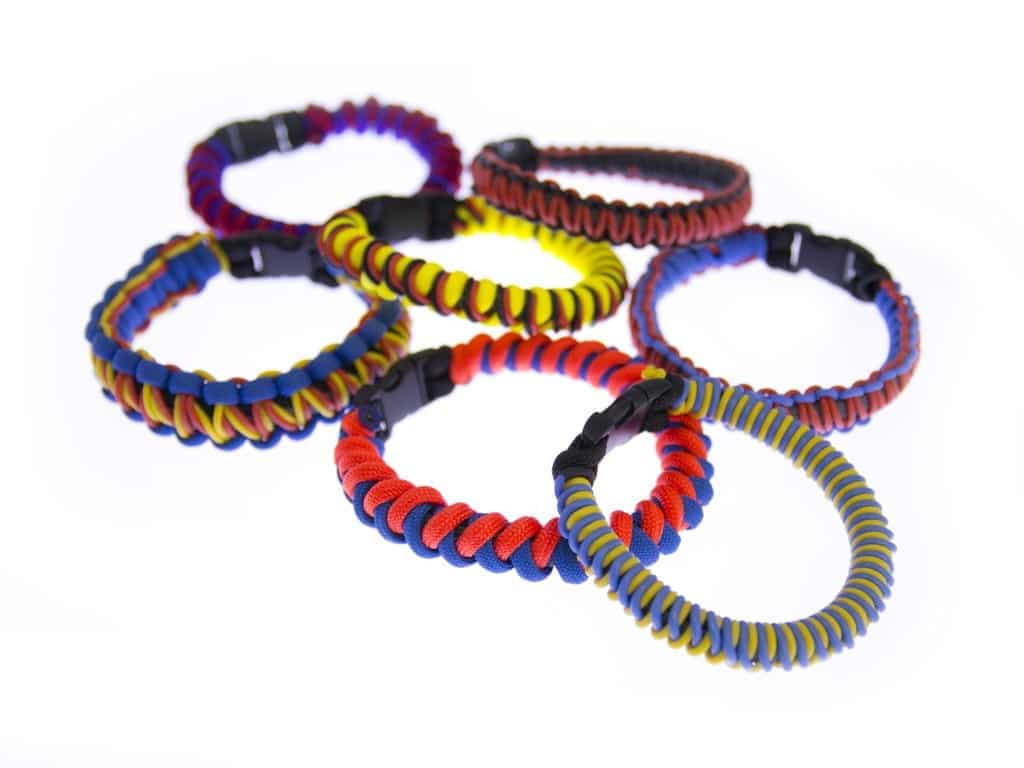Here's a link to a Smalltimes article where they interview Mark (and a few others) about using MEMS (or Micro Electromechanical Systems) in the toy industry. Read More...

The Solarbotics Repairacord™ Electroni...
Everyone is familiar with paracord bracelets - the cleverly woven wearable survival device that instantly unravels into many meters of useful and super strong nylon cord in case of necessity. These are useful for outdoorsy types, but what if you are an indoorsy type with a lot of electronic emergencies? Or a geek in need of a bright wrist decoration that shows off your geekness?
The Solarbotics Repairacord™ Electronics Survival Bracelet is what you need (complimentary pun included). Woven using traditional quick-release paracord weaves, it unravels in seconds, but instead of a regular electronically-inept nylon cord, it packs about 1.2m (4') of a high-quality 24-gauge 40-strand silicon wire. It can easily carry up to 2Amps, is wonderfully flexible and surprisingly wearable against the skin.
But should we say (infomercial style) wait - there's more! What good is wire if you can't utilize it properly? For ultimate electronics confidence, you'll find inside of each bracelet's core a payload sleeve containing a 15cm (6") length each of 3mm heat shrink and solder.

Now the only thing that you need is something to solder with. Out in the urban (or not so urban) jungle it could be a coin or a bare nail, which we have successfully tried.
So with Repairacord™ on your wrist, you are ready to repair the world - if you need to.
Features:
- choice of 17.8, 20.3 and 22.9cm lengths (7", 8" and 9" respectively)
- 3 styles:
- 2 quick release designs: sinnet and snake
- ... and endless color combinations!
Each bracelet features:
- 1.2M (~4’) of 24AWG, 40-strand tinned wire in a super flexible silicone insulator
- Up to 1.4M (~4.5’) of 550 LB Type III paracord (depending on the style/weave)
- 16cm (~6”) of 1/8" heat shrink and lead-free solder in hollow paracord payload sheathe.
Wearability:
We've been wear-testing several models for many months with great success, with each style offering their own set of characteristics:
The "All-wire" version is the most compact, but the silicone does start to show minor signs of abrasion after approximately 3 months continuous wear. And there's only the 16cm paracord payload sheathe to use for rope-work.
- Advantages: Lots of wire in tidy package
- Disadvantages: Only a minimum of hollow paracord for rope-work. Takes most effort to disassemble due to silicone's friction. Exposed wire shows signs of wear sooner than other models.
The "Hybrid" version blends the two different diameters of media together in a very visually appealing combination. It sits on your wrist with more visual presence than the "All-wire" version, taking advantage of the additional colors paracord offers. It also protects the exposed silicone wire much better, as the full type-III paracord makes up most of the exposed area.
- Advantages: Over 1M of true 550lb paracord available in addition to 2M of wire. Is visually the most pleasing.
- Disadvantages: Bulkier than "All-wire" model.
The "Armoured" model takes the most effort to create, as we replace the internals of the paracord with the silicone wire. This makes for a bracelet almost indistinguishable from a traditional paracord survival bracelet, and fully protects the wire from any abrasion.
- Advantages: Most traditional in appearance. Most robust. Disassembles into strands the quickest.
- Disadvantages: Bulkiest bracelet. Takes an extra step to extract the wire out of the paracord sheathe after disassembly. No full paracord used - only the 200lb sheathes for paracord applications. No obvious "geek factor" visible!
MORE POSTS
Look! Bird (-shaped bullets) made holes in bird... feathers! Well, not quite, although that would have been awesome too. Actually we were doing some nitrogen-assisted laser tests on various regular, i.e. boring materials, such as plywood and mat board. Then I came across some feathers and here's what it turned out to be: Now that […]
I missed the full segment of this story last weeks on "Discovery Channel's @discovery.ca" program, but fortunately, the've put the segment online at their website. I seems that JPL (Jet Propulsion Laboratories - NASA essentially) is working on a solar-powered, single-footed robot frog. This seems like a GREAT idea for extra-terrestrial planet-surface locomotion. Check out […]
The Turbot is a member of the Scophthalmidae family of flatfish and is almost completely circular. Turbot is often found partially buried in the seabed in sand, gravel, rocks and sediment. Its fat content varies, but it usually contains roughly 1 gram of omega-3 fatty acids per 100g fillet. Barring advances in genetic engineering, we will not be building that kind of Turbot. However, this kind of Turbot can be built with a soldering iron.
Solarbotics, Ltd. is not responsible for misprints or errors on product prices or information. For more information, please see our Terms and Conditions.
Warning: This product contains chemicals known to the State of California to cause cancer and birth defects or other reproductive harm.
Please visit www.P65Warnings.ca.gov for more information. This item was manufactured prior to August 31, 2018.

